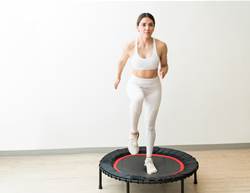If there were one miracle food or exercise that guaranteed a flat belly, you’d already know about it—and someone would be a billionaire because of it. But as our bodies change with age, so does the path to strong, defined abs. There’s no one-size-fits-all solution, but the good news is that the most important factors are still within your control—at every stage of life.
Ab strength isn’t just about how your jeans fit. A strong core helps prevent back pain, makes everyday movements easier, and supports balance and stability. To help you unlock these benefits, we spoke to nutrition, fitness, and women’s health experts—as well as women in their 30s, 40s, 50s, 60s, and 70s who prove that with the right approach, strong abs are always within reach.
“I have 50-year-old patients who’ve had three or more pregnancies and still maintain defined abdominal muscles,” says obstetrician and gynaecologist Dr Tyler Handcock. “The majority of these patients stick to a balanced diet and make time for a variety of exercise.”
Below, you’ll find expert-backed strategies for every decade—and a go-to ab routine to match.
The top two secrets to abs at any age
Food and exercise are your foundation—but only if you combine them the right way.
Certain foods can trigger spikes in insulin, explains registered dietitian Laura Mangum, and that can lead to excess fat stored around the belly. It’s common to try cutting out sugary foods or refined carbs, but many people replace them with artificial sweeteners. Mangum’s advice? Skip the gimmicks and prioritise whole, nutrient-dense options like lentils, beans, sweet potatoes, and pumpkin. These are packed with fibre and water, and they have a low glycaemic response—so they keep insulin levels steady. One of the best-researched eating patterns to support this is the Mediterranean diet.
And don’t fall into the trap of fearing carbs. As an exercise physiologist myself, I remind people that your body needs fuel to power through movement. To stay lean and strong, your routine should include both strength training and cardio—and carbs are your body’s most efficient energy source during high-intensity sessions.
To build visible abs, you also need to build muscle. That’s where strength training comes in. Sarcopenia, or age-related muscle loss, naturally softens the midsection. But it’s not inevitable. “Sarcopenia can be slowed with the right lifestyle habits—particularly strength training and balanced nutrition,” explains health coach Ayla Donlin.
To maintain muscle, Donlin says you need to challenge yourself. “If you’ve been doing lunges with 6 to 7kg dumbbells for years, try increasing to 8kg for a new stimulus. Small, progressive changes are both safe and effective.” Her most important advice? “Consistency is where the magic happens.”
No matter your age, it’s never too late—or too early—to start building a strong core. Begin with this five-minute warm-up, then scroll down for life-stage workouts that fit your decade and your lifestyle.
In Your 30s
Your focus: Building habits that stick
In your 30s, the key to core strength often comes from setting big movement goals—training for something like a long bike ride, hike, or group fitness challenge can naturally strengthen your abs without obsessing over aesthetics. At this age, pairing intense, goal-driven training with nutritious, energising meals helps build endurance and muscle tone. Instead of fixating on your appearance, commit to a fitness challenge that motivates you to stay consistent.
Abs tip for your 30s: Choose performance-based goals. Train hard, fuel properly, and let strength—not body image—lead the way.
In Your 40s
Your focus: Functional strength and family-friendly movement
In your 40s, exercise routines often involve juggling family life. Activities like running with a pram, cycling, or hiking not only keep you active but also build lean muscle. Muscle definition often reflects body fat levels, which can be influenced by outdoor movement and mindful eating. Classic exercises like push-ups remain one of the most effective ways to train the abs—especially when you progress gradually to harder variations.
Abs tip for your 40s: Incorporate compound bodyweight moves like push-ups into your routine. Level up slowly and track your form for strength and tone.
In Your 50s
Your focus: Mind-body connection and intuitive movement
At this stage, sustainable wellness becomes more personal. Tuning in to what feels good, being grateful for what your body can do, and making time for rest and recovery are just as important as physical training. Breathing techniques, meditation, and gentle core work can strengthen not just your abs but also your awareness. Small, consistent efforts add up—especially when you choose movement that brings joy.
Abs tip for your 50s: Listen to your body, prioritise core-focused activities you enjoy, and focus on consistency over intensity.
In Your 60s
Your focus: Stability, back care, and strength maintenance
Core strength in your 60s often becomes more about preventing back pain and improving daily function. Prioritise exercises like planks, bridges, and Bird Dogs to build deep abdominal and spinal support. Don’t shy away from heavier weights—with the right form, lifting can increase muscle mass, boost metabolism, and help with posture and balance.
Abs tip for your 60s: Train for function. Prioritise stability-based exercises and use strength training to support your metabolism and muscle tone.
In Your 70s
Your focus: Flexibility, joint mobility, and energy
Mobility becomes essential in your 70s. Daily stretching routines that target the hips, shoulders, and spine can help maintain flexibility and prevent injuries. Strength training, even just twice a week, supports bone health and preserves independence. Minimising sugar and fuelling with a mix of protein, complex carbs, and healthy fats also supports energy and body composition.
Abs tip for your 70s: Stretch daily, keep moving in ways you love, and fuel your body with nutrient-dense meals. Gentle core work can be done from a seated position if needed.









